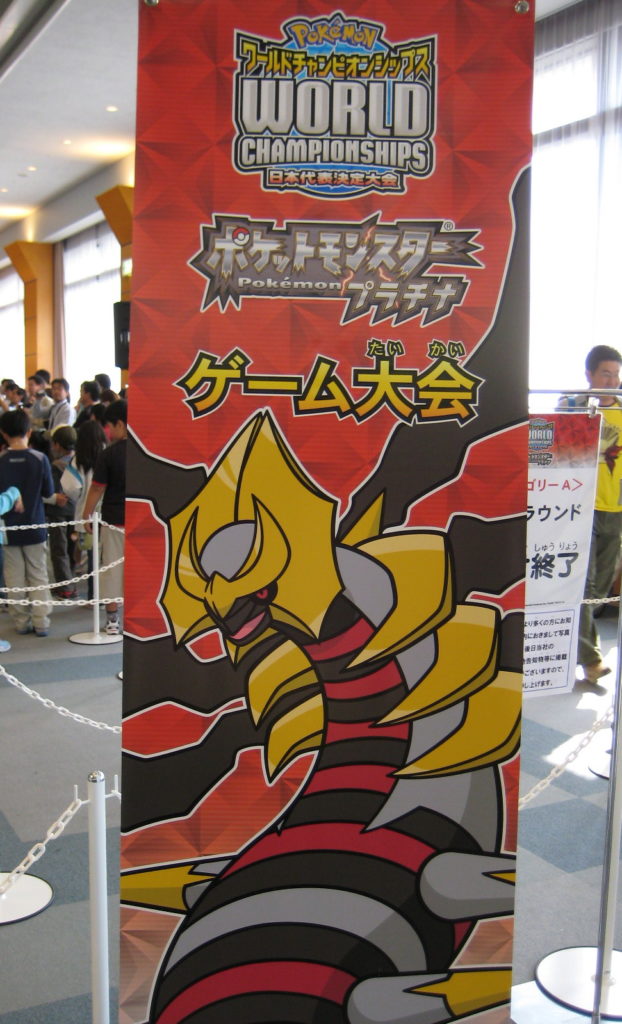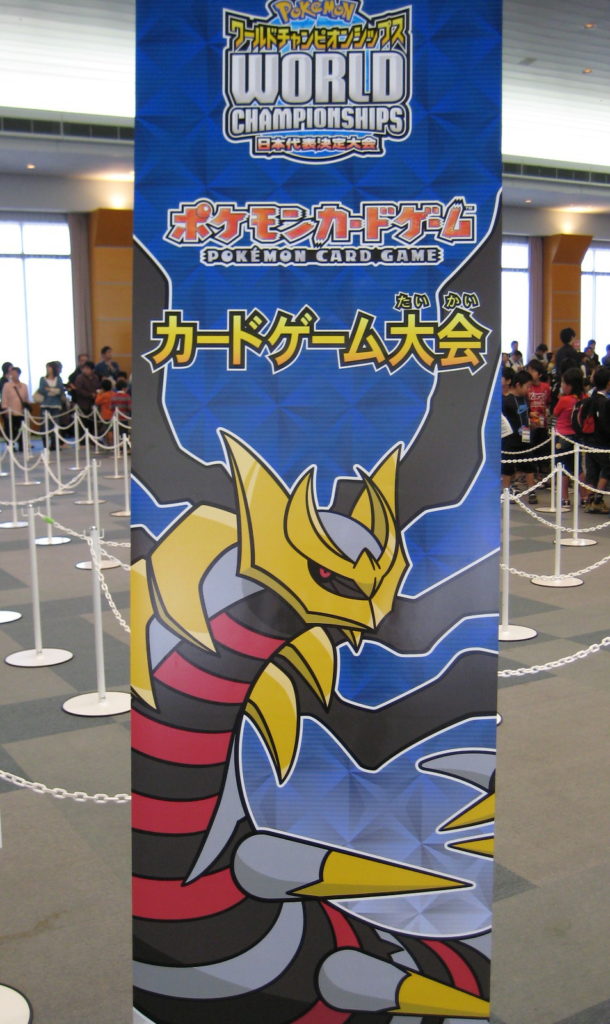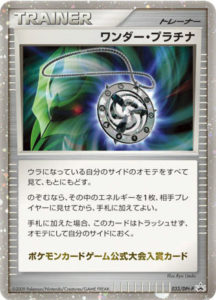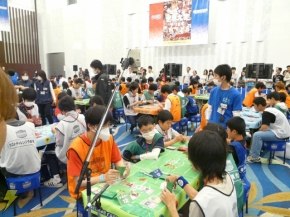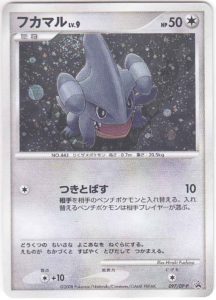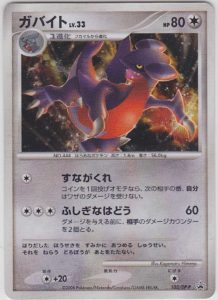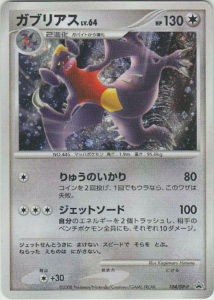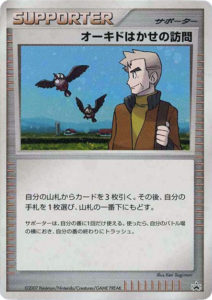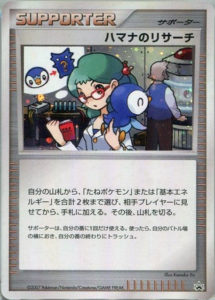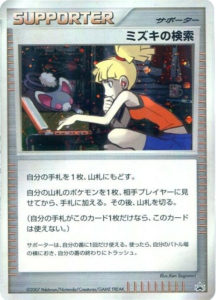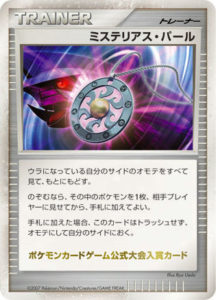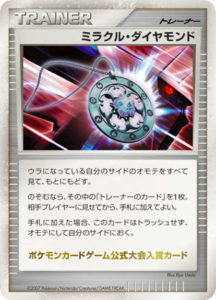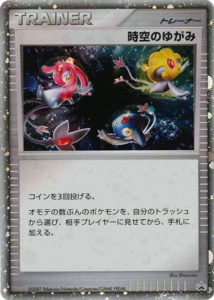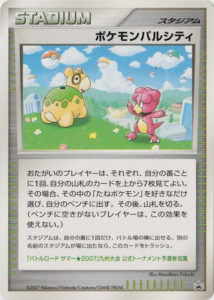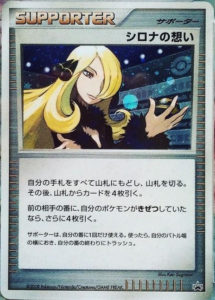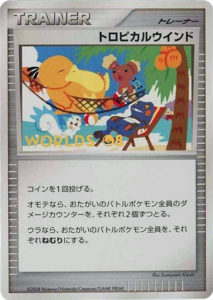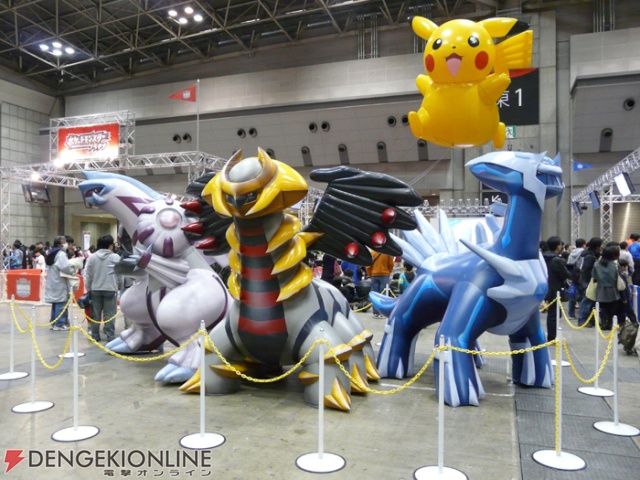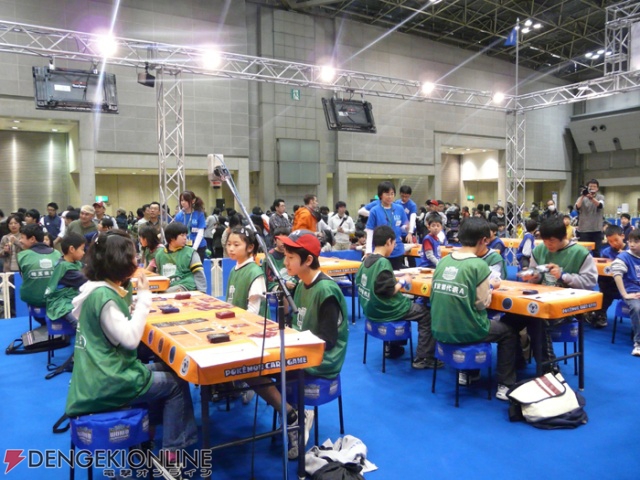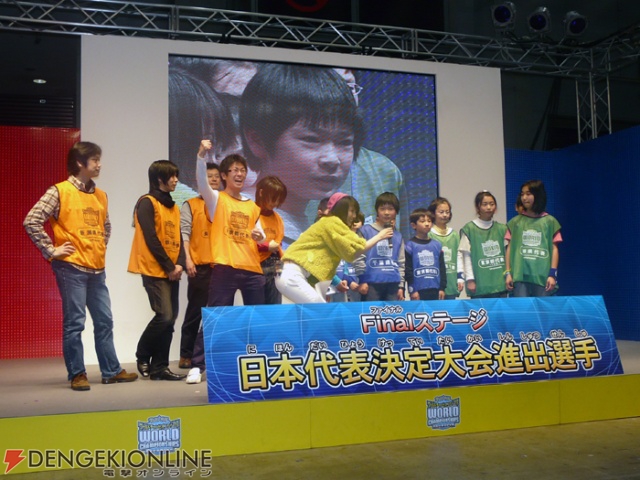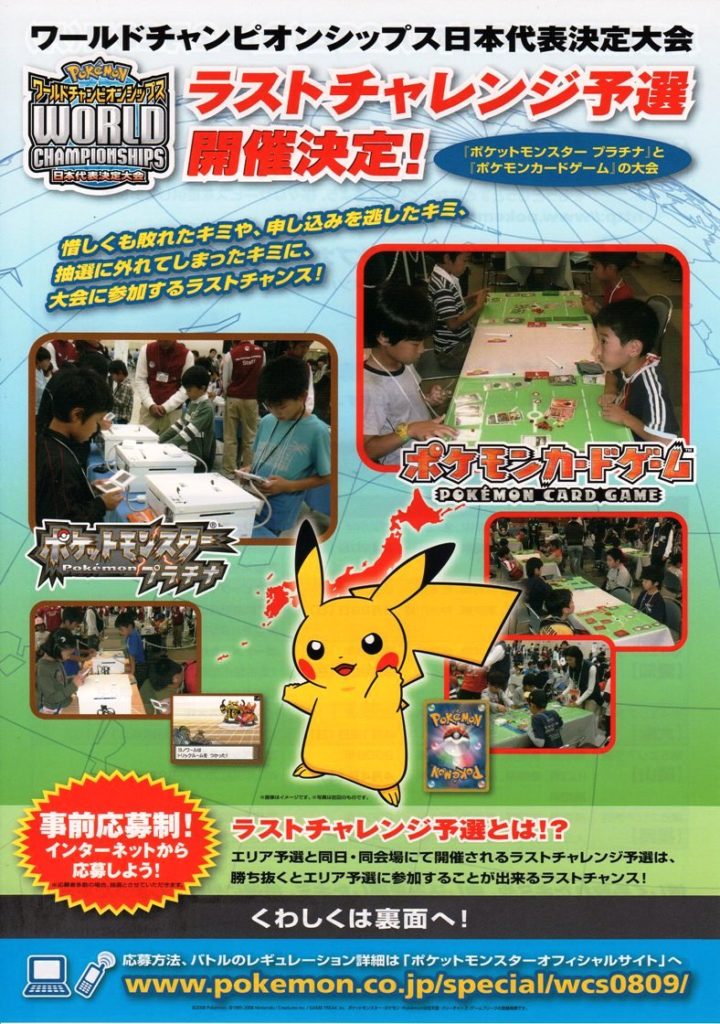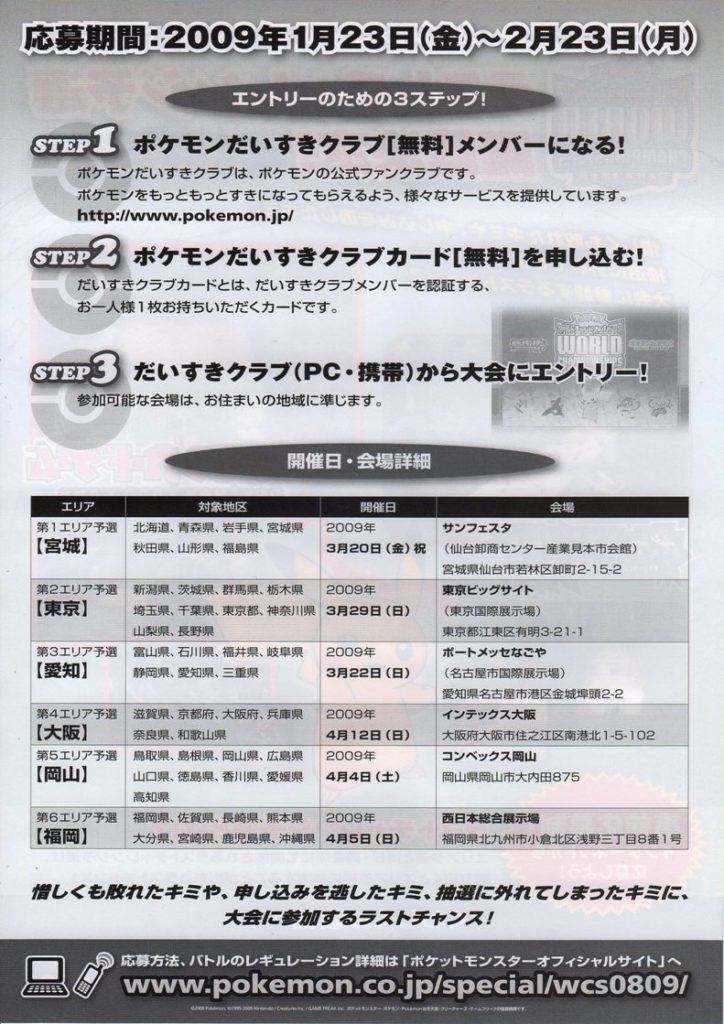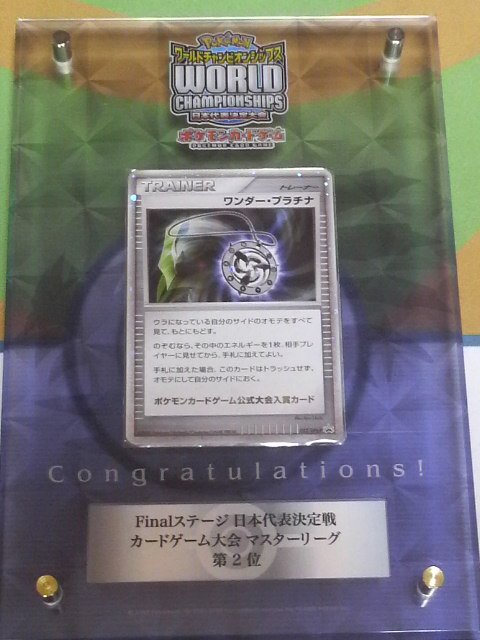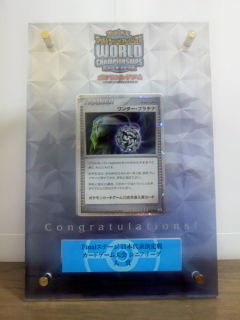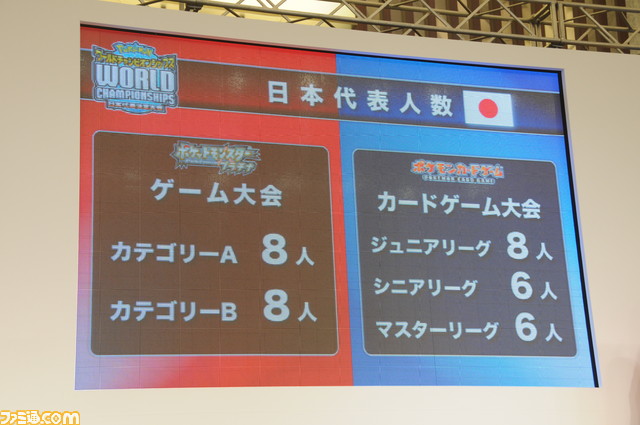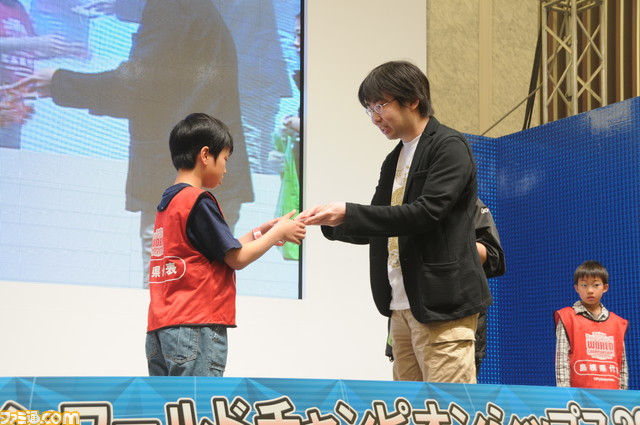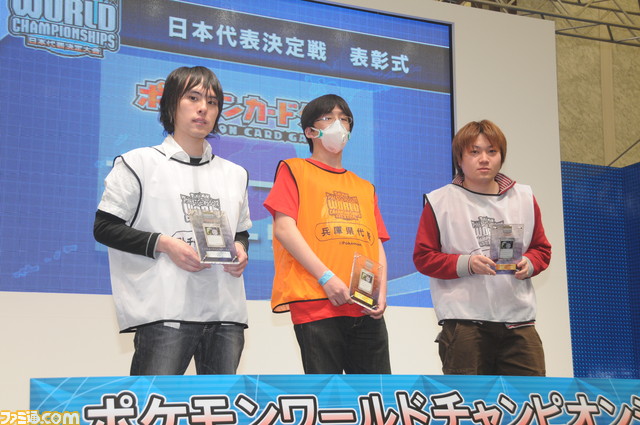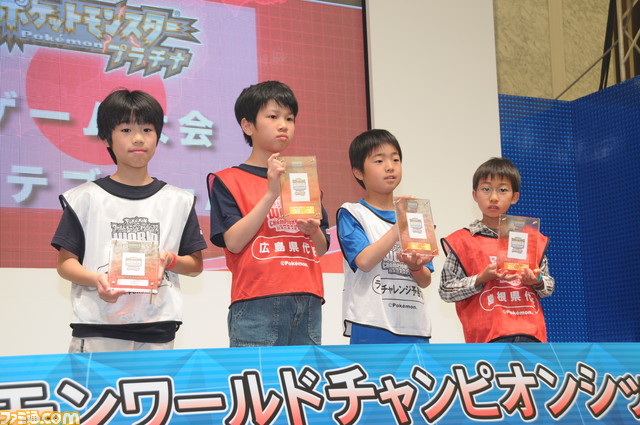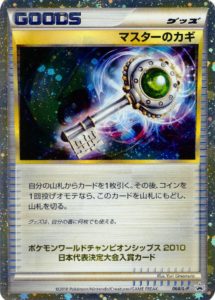In the fall of 2008, Japan’s organized play scene resumed its large-scale regional tournaments after the cancellation of Battle Road 2008.
This new tournament circuit was aptly named the Japan World Championship Representative Tournament, and it culminated with the selection of the players would would represent Japan at the 2009 World Championships. It would also be known as the Pokemon World Championship Series (Pokemon WCS).
The regional tournaments were no longer held in a just few locations nationwide. Instead they were held in 3 stages, with the 1st stage being held much more widely, and the 2nd stage narrowing down the field to a smaller number of players. The final stage would be similar to the “Best in Japan” national championship battles held in years past.
This tournament series was the only source of the Wonder Platinum trophy card.
Unlike the Battle Road tournaments (which only featured the TCG), both video game players and TCG players would be playing at the same tournament venue to decide who would proceed to the World Championships.
Both the video game and TCG winners would receive the Wonder Platinum card.
1st Stage
Also known as the “Qualifying Stage”, this was held in 47 prefectures across Japan. This was a dramatic increase from the usual 5-7 prefectures from the previous Battle Road tournaments. They started with the Hyogo prefecture tournament on October 12, 2008, and concluded with the Tokyo B tournament on January 25, 2009.
By winning this stage of the tournament, players would be able to advance to the “2nd stage” events, which were held at 6 venues nationwide.
Participants of the 1st stage would received a sealed cellophane pack containing 3 cosmos holofoil promo cards: Gible, Gabite, and Garchomp.
Entry
Players had to be members of the Pokemon Daisuki club to pre-register for the tournament. Participants were selected from the pre-registered players by lottery. They would be notified via email within 5 days after applying if they had been selected.

There were 4 “reception periods” during which players could apply for the lottery to enter. During each of these reception periods, certain prefectures would be available to enter the lottery for.
1st reception period: August 11, 2008 – September 22, 2008
Miyagi, Akita, Niigata, Nagano, Saitama, Chiba, Shizuoka, Hyogo, Yamaguchi, Tokushima, Fukuoka, Kagoshima
2nd reception period: September 19, 2008 – October 27, 2008
Hokkaido, Aomori, Iwate, Yamagata, Fukushima, Ishikawa, Fukui, Yamanashi, Shiga, Kyoto, Wakayama, Tottori, Shimane, Ehime, Okinawa
3rd reception period: October 17, 2008 – November 24, 2008
Toyama, Tochigi, Aichi, Osaka Day 1, Osaka Day 2, Hiroshima, Kochi, Saga, Kumamoto, Oita
4th reception period: October 31, 2008 – December 8, 2008
Ibaraki, Gunma, Tokyo A, Tokyo B Day 1, Tokyo B Day 2, Kanagawa Day 1, Kanagawa Day 2, Gifu, Mie, Nara, Okayama, Kagawa, Miyazaki
Tournament Structure
Similar to previous official tournaments, players were split into junior, senior, or masters league depending on their age:
- Junior League: Born after 1998
- Senior League: Born 1994 – 1997
- Master League: Born before 1993
The 1st Stage tournament was split into 2 parts: the qualifying round and the final tournament. This was very similar to how the Battle Road tournaments were split.
All age divisions played in both the qualifying round and final tournament with 30-card half decks. This was a departure from how regional tournaments were previously run, as usually in the final tournament players would use full 60-card decks.
Qualifying Round
This round was held in a “Round Battle” format, also known previously as “Stage” format. Players started at the first round, and winning that round would move them to the next round, while losing would reset them to the first round.
Winning in the final round would earn players entry into the final tournament. Games during the qualifying round had no time limit, but since players could re-queue up to progress through the stages, fast play was incentivized. Games were played with 3 prizes.
The qualifying round would end when all the slots for players in the final tournament had been filled at each venue.
Final Tournament
Similar to final tournaments in previous years, this was a single-elimination tournament between all the players who had made it through the previous qualifying round. Games had a time limit of 15 minutes.
Allowed Cards
With a new tournament series, many older cards rotated out of competitive play. Since the tournaments spanned multiple months from the end of 2008 to the start of 2009, newly released cards caused slightly different metagames at later tournaments. Cards from the following expansions, pre-constructed decks, and promos were available (Japanese equivalents in italics):
Expansions:
- Diamond & Pearl (Diamond Collection and Pearl Collection)
- Mysterious Treasures (Secret of the Lakes)
- Secret Wonders (Shining Darkness)
- Great Encounters (Moonlit Pursuit and Dawn Dash)
- Majestic Dawn (Moonlit Pursuit and Dawn Dash)
- Legends Awakened (Cry from the Mysterious and Temple of Anger)
- Stormfront (Fierce Battle in the Destroyed Sky)
- Platinum (Galactic’s Conquest)
Preconstructed Decks / Special sets
- DPt-marked Entry packs
- Gift Box Preconstructed decks
- Random Construction Starter Decks
- DP-marked Construction half decks
- DP-marked Competitive Starter decks
- DP-marked Construction standard decks
- Battle Starter pack “Heatran vs. Regigigas”
- Movie 10th Anniversary Premium Set
- Movie release commemorative premium sheet 2008
- DP-P promo cards
- PPP promo cards
Additionally, the following 12 unnumbered promo cards (and all variants of Pokemon Pal City) were allowed for play. In particular, the Mysterious Pearl and Miracle Diamond cards had unique effects which were actually quite playable.
2nd Stage
The 2nd Stage was open to the winners of the 1st stage tournaments, but also open to the general public through the “Last Chance Qualifiers” held at each location. Winners of this stage would advance to the “Final Stage” tournaments to determine the Japan National Champions.
There were 6 2nd Stage tournaments, and they were structured as larger regional tournaments, similar to the Battle Road tournaments in previous years.
Competitors would wear jerseys displaying what prefecture they were from. These were also in different colors, but it’s unclear what the colors mean.
Entry
All winners of the 47 1st Stage tournaments were given preferential entry into the 2nd Stage tournaments, which were held in 6 locations nationwide. Each of these 6 tournaments would host local prefectures from the 1st Stage winners.
1st Area: Miyagi Tournament: March 20, 2009 at Sun Festa (Sendai Wholesale Center Industrial Trade Fair Hall)
Hokkaido, Aomori, Iwate, Miyagi, Akita, Yamagata, Fukushima prefectures
2nd Area: Tokyo Tournament: March 29, 2009 at Tokyo Big Sight (Tokyo International Exhibition Center)
Niigata, Ibaraki, Gunma, Tochigi, Saitama, Chiba, Tokyo, Kanagawa, Yamanashi, Nagano prefectures
3rd Area: Aichi Tournament: March 22, 2009 at Port Messe Nagoya (Nagoya City International Exhibition Center)
Toyama, Ishikawa, Fukui, Gifu, Shizuoka, Aichi, Mie prefectures
4th Area: Osaka Tournament: April 12, 2009 at Intex Osaka
Shiga, Kyoto, Osaka, Hyogo, Nara, Wakayama prefectures
5th Area: Okayama Tournament: April 4, 2009 at Convex Okayama
Tottori, Shimane, Okayama, Hiroshima, Yamaguchi, Tokushima, Kagawa, Ehime, Kochi prefectures
6th Area: Fukuoka Tournament: April 5, 2009 at West Japan General Exhibition Center
Fukuoka, Saga, Nagasaki, Kumamoto, Oita, Miyazaki, Kagoshima, Okinawa prefectures
Last Chance Qualifier
In addition, each of the 6 tournament venues featured a “Last Chance Qualifier”. This allowed players who hadn’t won an opportunity in the 1st Stage another chance to try and get into the Final Stage tournament. This was also known as the “Last Challenge”.
Players who wanted to play in the “Last Chance Qualifier” would need to apply by lottery from January 23, 2009 – February 23, 2009.
Tournament Structure
Similar to the 1st stage, players were split into junior, senior, or masters league depending on their age:
- Junior League: Born after 1998
- Senior League: Born 1994 – 1997
- Master League: Born before 1993
Since these tournaments featured the “Last Chance Qualifier” tournaments as well, there were 2 different tournament structures at each event depending on if players were in the 2nd Stage tournaments, or the Last Chance Qualifier ones.
2nd Stage Tournament Structure
The 2nd Stage tournament format was “Swiss Draw”. A swiss-system tournament is a non-elimination tournament where there was a fixed number of rounds. Each player would be paired against another player with a similar record, and players would get points depending on the results (likely 2 points for a win, 1 point for a draw, and 0 for a loss).
2nd Stage players would play games with full 60-card decks, 6 prizes, and a 20 minute time limit. The players with the highest total points would be eligible to participate in the “Final Stage” tournament. The number of players selected differed at each venue.
Last Chance Qualifier Tournament Structure
The Last Chance Qualifiers were held in an identical way to the 1st Stage tournaments. They were split into a Qualifying Round (which featured the “Round Battle” structure) and a Final Tournament (Which was held as a single elimination tournament). This meant that similar to the 1st Stage tournaments, players in the Last Chance Qualifiers would play games with 30-card half decks.
Winners of the Final Tournament in the Last Chance Qualifiers would earn the right to participate in the venue’s 2nd Stage tournament.
Allowed Cards
All cards from the 1st Stage tournaments were allowed during the 2nd Stage. In addition, the following Platinum (DPt) era products had been released, and were added into the card pool:
- Rising Rivals expansion (Bonds to the End of Time)
- Battle Starter Pack SP “Infernape vs. Gallade”
- DPt-P promos
Final Stage
The Final Stage tournament was held on May 4, 2009 at the Prince Park Tower Tokyo. There, the both the video game and TCG winners of the 2nd Stage would play to determine national champions.
This stage of the tournament is what awarded the Wonder Platinum trophy card.
Tournament Structure
Because both video game players and TCG players received the Wonder Platinum card, it is necessary to count them all to determine the total population.
TCG Final Stage Tournament Structure
The TCG tournament was again split into 3 age divisions:
- Junior League: Born after 1998
- Senior League: Born between 1994 – 1997
- Master League: Born before 1994
The TCG’s Final Stage used the same “Swiss Draw” system as the 2nd Stage tournaments. This is a non-elimination tournament where there was a fixed number of rounds. Each player would be paired against another player with a similar record, and players would get points depending on the results (likely 2 points for a win, 1 point for a draw, and 0 for a loss).
VGC Final Stage Tournament Structure
The video game championships (VGC) players were also split into 2 groups based on age:
- Category A: Born after January 1, 1997
- Category B: Born before December 31, 1996
The VGC tournament was played on Pokemon Platinum games, and utilized the “Double Battle” format. All participants were divided into 4 groups and competed in a Swiss Draw tournament. The top 8 players in each category A or B would participate in the finals.
Winners
In total, 36 Wonder Platinum cards were officially distributed to winners of the TCG and VGC. They were distributed in acrylic plaques that denoted their placement and which game (TCG or VGC) they were won from. The TCG plaque were blue in color, while the VGC ones were red. Both featured a silhouette of Giratina in the background.
The TCG tournament produced 8 Junior League, 6 Senior League, and 6 Master League winners for a total of 20 winners. The VGC tournament produced 8 Category A winners and 8 Category B winners.
The TCG tournament’s top 3 winners in each age division and top 4 winners of each VGC category were brought onto the main stage to receive their prizes.
TCG Winners
Several of the winners had actually made it into the finals from the Last Chance Qualifier (also known as the “Last Challenge”) events held at the 2nd Stage tournaments. Additionally, two of the Senior League winners had gained entry into the Final Stage via their wins in Battle Road Spring 2008.

- Takumi Kiyota (Kanagawa 1)
- Daima Kiyooka (Chiba)
- Takemura Rack (5th Last Challenge)
- Fumiya Higashihara (Saga)
- Satoshi Takahashi (Oita)
- Kaiyuki Yamaguchi (3rd Last Challenge)
- Matsuura Hitora (Tokushima)
- Arai Soma (Tokyo B 1)
Video Game Championship Winners
The VGC competition had 8 winners in each of the Category A or Category B groups. These groups were based off competitor age, but with a smaller breakdown when compared to the TCG’s 3 age divisions.
Legacy
After the annual regional tournaments were unexpectedly cancelled, the Japan World Championship Representative Tournament was a strong return for both the Pokemon TCG’s and VGC’s competitive play scenes.
This tournament kicked off the tradition of having both the TCG and VGC’s national championships at the same location. Additionally, the new tournament structure of including more prefectures in the initial stages before narrowing down into large regional tournament was repeated again the next year. Following in the footsteps of the Wonder Platinum, the next year’s 2009 – 2010 national championships would feature a new trophy card for finalists, the exclusive Master’s Key.
Sources
- https://web.archive.org/web/20080901202823/http://www.pokemon.co.jp/special/wcs0809/card/
- https://web.archive.org/web/20080901120820/http://www.pokemon.co.jp/special/wcs0809/about/
- https://asami-1120.hatenablog.com/entry/20081211/p1
- https://web.archive.org/web/20080901093721/http://www.pokemon.co.jp/special/wcs0809/site/
- https://web.archive.org/web/20090221000100/http://www.pokemon.co.jp/special/wcs0809/card/reg02.html
- https://web.archive.org/web/20081218145814/http://www.pokemon.co.jp/special/wcs0809/card/reg01.html
- https://web.archive.org/web/20081214210056/http://www.pokemon.co.jp/special/wcs0809/challenge/
- https://www.4gamer.net/games/063/G006335/20090507057/screenshot.html?num=007
- https://www.4gamer.net/games/063/G006335/20090507057/
- http://murasaki-labs.org/library/wcs2009.htm
- https://83664.diarynote.jp/200905082153012644/
- https://www.famitsu.com/game/news/1223970_1124.html
- https://www.famitsu.com/image/1140/QOmYVjptryZpekOya9yTxPy935DG9wgC.html





